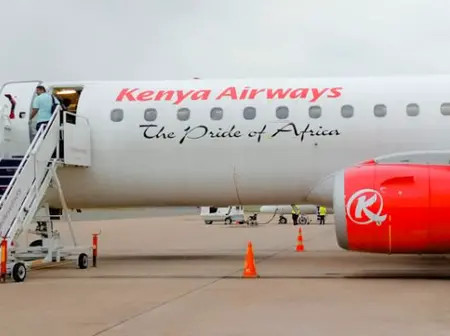Kenya Airways is facing fresh pressure from lawmakers to spell out how it intends to repay billions of shillings in government bailouts, as the loss-making national carrier leans heavily on taxpayer support to stay afloat.
“KQ could not settle this debt due to cash flow pressure attributed to the impact of the COVID-19 pandemic. A shareholder loan agreement between GoK and KQ is currently being finalized and should be signed within the next about two months,” said the Kenya Airways Chief Executive Allan Kilavuka.
The committee members stated that repeated bailouts have not been matched by clear steps toward financial recovery. The airline swung back into the red after reporting a KSh12.15 billion half-year loss through June, one of its largest in over a decade.
Meanwhile, its revenues fell 19% to KSh74.5 billion, weighed down by grounded Boeing 787 Dreamliners, supply chain shortages and reduced capacity. This marked the 13th loss in the past 14 half-year periods for the carrier.
The parliamentary scrutiny also follows a February report by the Auditor-General, which faulted the Treasury for extending over KSh55 billion to Kenya Airways between 2019 and 2023 without a clear loan recovery plan.
The audit found no formal loan agreements, collateral, or repayment framework for the government’s exposure, raising doubts about the recoverability of the funds. Despite that, the Treasury has since continued to shoulder KQ’s obligations, including offering a KSh19 billion bond swap to a consortium of lenders in late 2024.
Since 2020, all disbursements to Kenya Airways have been secured by shareholder loan agreements, but repayments remain scant.
During the release of the half-year results, Kilavuka stated that Kenya Airways is pursuing a US$500 million recapitalization plan to stabilize liquidity, restore aircraft availability and fund new routes.
Kilavuka also traced the airline’s financial unraveling back to the failure of Project Mawingu, an ambitious expansion plan launched more than a decade ago. He cited a series of blows including terrorism advisories that dampened tourist arrivals, a 2013 fire at Nairobi’s Jomo Kenyatta International Airport (JKIA) that cost the carrier US$4 million, and the Ebola outbreak in West Africa in 2014 that derailed the strategy.
“The delayed delivery of B787 aircraft whose entry into service per Project Mawingu plan was in 2013/14 but were delivered in 2014/2015 led to the sourcing of alternatives aircraft (B777) where 2 were delivered in 2013/2014, a much larger and more expensive alternative. This resulted in high fleet operational and maintenance costs,” Kilavuka told the Committee.
As lawmakers weigh privatization options and stricter repayment terms, Kenya Airways finds itself squeezed between its ambition to recover and a political demand for accountability.

Leave a Reply